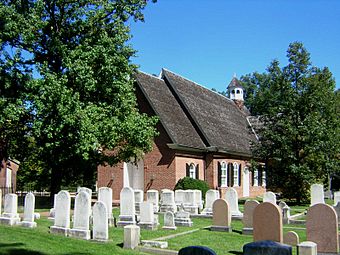St. Thomas Church (Owings Mills, Maryland) facts for kids
Quick facts for kids |
|
|
St. Thomas Church
|
|

From the south
|
|
| Location | 260 St. Thomas Lane, Owings Mills, Md |
|---|---|
| Area | 8 acres (3.2 ha) |
| Built | 1743 |
| Architectural style | Georgian |
| NRHP reference No. | 79001117 |
| Added to NRHP | May 24, 1979 |
St. Thomas' Episcopal Church is a historic church in Owings Mills, Maryland. It is part of the Episcopal Church and has been around since 1743. The church is known for its beautiful old building and its long history in the area.
Contents
A Look Back: Church History
The church was first approved in 1742 by the government of Maryland. It was built as a "Chapel of Ease." This meant it was a smaller church for people who lived far from the main church. It helped people in the Garrison Forest area attend services more easily.
The first minister, Reverend Thomas Craddock, started his work on January 14, 1745. Later, in 1782, Reverend John Andrews became the church's leader. He served until 1784. Many important people were early members of St. Thomas Church. These included Christopher Gist, an explorer, and John Eager Howard. Howard was a famous soldier, and nearby Howard County is named after him! Sequoyah, who created the Cherokee writing system, and his mother, Wut-teh, were also early members.
Church Design: Architecture Over Time
The first church building was finished in 1743. It was made of red brick and looked like a simple rectangle. It had eight windows with rounded tops, which still have much of their original glass from 1743. There were also three windows on the west side and a small one near the roof. The main door was on the south side. Inside, it had a wide, brick aisle and white box pews (enclosed seating areas), which are still there today.
Later, in the late 1800s, the church changed. The south door was removed. A new entrance was made on the west side. In 1891, new sections called transepts were added. These are like arms that stick out from the main building. A small, rounded area called a chancel was also added. These changes made the church look like a cross, which is called a cruciform shape.
The church has some special windows. One is a lancet window (a tall, narrow window) on the east side. It was made by John LaFarge and shows the Ascension. Another beautiful window was added later by Tiffany. The transepts have round windows, called rose windows, with colorful glass.
In 1970, the church had a big restoration. This included adding a narthex to the west side. A narthex is an entrance hall at the front of a church. This new part also gave access to a new basement.
Historical Importance
St. Thomas Church has been recognized for its long history.
- In 1936, a special sign was put up by the road. It says the church was approved in 1742 as a "Chapel of Ease." It also mentions Reverend Thomas Craddock as the first minister in 1745.
- The church was added to the National Register of Historic Places on May 24, 1979. This means it is a very important historical site in the United States.
The Graveyard
The church has a cemetery where many important people from the area are buried. Some graves date back to the 1700s, but many of the oldest markers are hard to read now.
Notable Burials
- Hetty Cary: She is remembered for helping to make the first three battle flags of the Confederacy.
- Samuel Owings: He was a very successful miller. The town of Owings Mills was named after him!
- Edgar Allan Poe: He was an Attorney General for Maryland. He also played quarterback for the Princeton Tigers football team.
- Sam Shoemaker: He was born in this church's parish and became a well-known clergyman.
- Daniel Brewster: He served as a U.S. Senator for Maryland.
Images for kids







